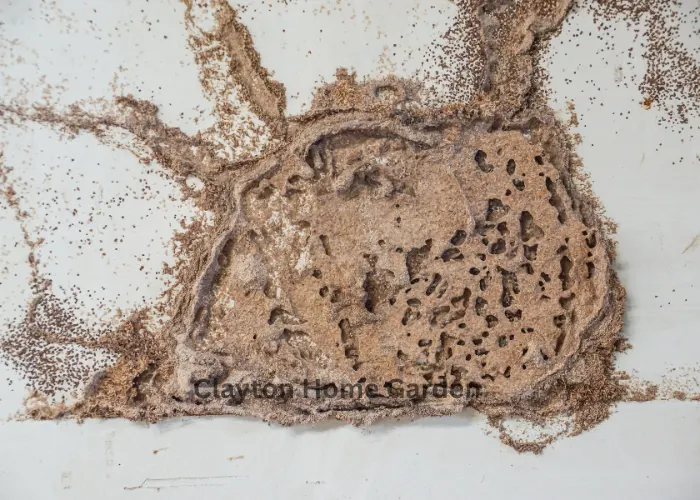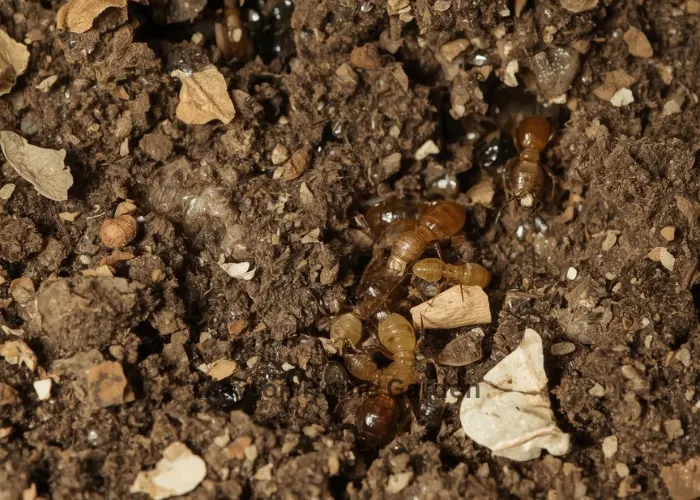What Do Termite Droppings or Frass Look Like?

If you’re finding termite feces in your house It’s not just an issue. It’s a sign something more serious is happening. Termite droppings, sometimes referred to as frass, are usually a sign that you’ve got an infestation of termites. What do they actually look like? Let’s look at it in detail and discuss what may be dealing with.
Termite Excrement or “Frass”
Termites can be quite destructive and frass is among of the first things they take away. Frass refers to the small pellets they produce as they chew through wood. The most common source is drywood termites that consume wood in your U.S home and then expel the wood through tiny holes.
The appearance and color of termite fess can differ however, it’s typically lighter brown or dark and sometimes black. Although it might look similar to sawdust, termite feces generally have a uniform form and texture. If you see the droppings scattered on furniture, wooden beams or on the floor it’s time to look into the matter.
Drywood Frass: What Do Drywood Termite Droppings Look Like?

If you’re experiencing drywood termites, their droppings are easy to identify. They typically appear like tiny particles of sand that tend to be dark in shade. They burrow into wood and make tiny holes through which they release frass. They are typically found close to wooden surfaces, window sills or under wooden furniture.
The most interesting thing about the drywood termite’s droppings is that they tend to accumulate beneath wooden beams, or in areas in which wood is exposed. One thing that is somewhat uncomfortable is that you might see drywood termite droppings, but not actually notice any termites. They’re hidden in the wood, which means you’ll never see them directly but there is evidence to suggest.
What Do Termite Pellets Look Like?
When we refer to termite pellets, we’re talking to the fass or droppings left behind by termites. These pellets are tiny and round, and appear similar to grains of coffee grounds or sand. If you’re surrounded by carpenter ants their droppings, they may appear like the termite ones, however, they tend to be smaller and are more uniform in dimensions and shapes.
To detect termite feces You should look for tiny solid pellets that are darker in color than sawdust. The pellets are typically found in areas of damaged wood in the form of a sludge in the window’s bottom and on wood floors or in the vicinity of window sills.
Subterranean Frass: What About Subterranean Termite Droppings?

In contrast to drywood termites and subterranean termites are underground and make their nests in the wood which are common in the U.S. Although the droppings of subterranean termites are more difficult to identify but they do leave evidence of their activities. Frass of theirs appears more granular appearance and is often blended with soil.
Subterranean termites are typically found in droppings in the foundation of your house and in places where termites have entered gaps or cracks. If you notice this kind of frass, it’s important to take action promptly, since termites living in subterranean areas are known for causing serious destruction to homes if they are not treated in a timely manner.
What Do Termite Droppings Look Like?
Now, let’s discuss the basics: What do termite droppings look like? They’re frequently mistaken for sawdust or wood dust, but they’re in fact tiny pellets, typically darker brown, or even black. They can also be white, based on the kind of wood that termites eat.
If you see termite droppings around wooden beams, as well as on your floor it’s an obvious indication that termites have entered your home. The color of their droppings will tell you much about the type of wood they’ve consumed. Drops that are darker could mean termites are eating hardwoods, while lighter drops might be evidence of soft wood.
Are Termite Droppings Dangerous?
The droplets themselves are usually safe. However being aware that termites live within your home is a more serious issue. Termite droppings indicate that termites are consuming the wood, and could cause significant destruction to the structure of your house. They weaken wooden structure over the years, which can compromise the strength of beams, walls and floors.
Furthermore dust resulting from termite droppings could be irritant to those suffering from respiratory issues. If you notice droppings in your bathroom, attic or living spaces this could be a sign of an infestation that is more extensive. While the waste itself isn’t harmful, it’s important to address the issue promptly to avoid long-term destruction.
What to Do if You See Termite Droppings
If you find termite droppings within your home, don’t be afraid, but act now. Here’s how to deal with it:
- Find the droppings If they resemble coffee grounds or sand grains They’re probably drywood termites.
- Examine for damage: Look for small holes or damaged areas that could be indicative of termites that are active.
- Contact a professional It’s recommended to speak with an expert in pest control to assess your home and address the problem.
The sooner you spot termite feces, the easier it is to avoid any further destruction. If you can address the issue in the early stages, you’ll reduce the cost of repairs and avoid problems later on.
How to Get Rid of Termite Droppings
When you’ve discovered termite feces getting them cleaned off is essential however it’s only the beginning. What you need to do:
- Vacuum the frass with the vacuum equipped with an HEPA filter to stop dust from spreading.
- Clear the area to prevent further termites from coming back.
- But, cleaning the feces isn’t enough. You’ll have to deal with the cause of the issue, which is the termites themselves. Pest control techniques that are professional, such as fluid treatments or fumigation are usually the most efficient methods to get rid of termites.
What Do Termite Droppings Look Like Inside?
In certain instances there may be termite faeces in the carpets or walls. This is usually an indication that the termites are reproducing and feeding in the wood, and there may not be access to the area the areas where they’re nesting. If you see droppings in areas that there isn’t any visible wood, it’s a great idea to consult an expert to look into the extent of damage.
How Termite Droppings Affect Your Home’s Value
Termite feces aren’t only evidence of an infestation, they could also impact how much value you place on your house. If you allow termites to develop and you don’t take action to tackle the issue, you could end up with serious structural damage that can be expensive to fix. Homebuyers are cautious about properties with termite debris because they are concerned about hidden damages. Even if the termites have gone, the expense of repairs may reduce the value of your home’s property.
Here’s how you can safeguard your home’s resale value:
- determine if termites remain.
- Repair the damage caused by termites. This will show the buyer that you’ve addressed the issue.
- Check the property for termites prior to showing it off to prospective buyers.
- You must provide proof of treatment if you’ve hired a professional control company, provide buyers with the evidence that the home was treated and is in warranty.
Termite Droppings vs Other Pests: A Detailed Comparison
You may be seeing droppings in your home and you’re wondering if they’re termites or some other kind of pest. Here’s how you can tell the distinction:
- Termite Droppings: Small cylindrical pellets, typically dark black or brown, that are found close to wood.
- Ant Droppings: irregularly form and come mostly from foods, not wood.
- Carpenter Ant Droppings: Much larger than the termite pellets they are mixed with wood pieces because Carpenter ants dig up wood.
- Cockroach Droppings typically shiny, black and larger than termite pellets. They are and not made from wood.
Knowing the difference will help you determine what insect is creating the problem and helps you take the correct step.
Signs of an Infestation Before You Spot Droppings
When you first notice termite feces, the pest could already be causing damage. These are other signs to be on the lookout for:
- Wood that is hollow or weak If wood sounds hollow when you tap it termites could be feeding on it.
- The termites that live in the subterranean region typically create mud tubes around your foundation.
- Sawdust-like particles: You could see wood dust on the baseboards or wood beams.
- Wings that have been discarded: When termites gather, they shed wings. If you see a cluster of wings, it is likely that you might have an issue.
Is it Always Termite Droppings? What Else Could It Be?
Small pellets and debris come from termites. It is possible that they are also caused by other insects:
- Carpenter ants drop droppings composed of wood pieces.
- Rodents produce small black, elongated, black droppings.
- Cockroaches have black, cylindrical droppings that are more than the termite pellets.
If you’re not sure the issue, a pest expert will be able to help you identify the problem.
Final Thoughts: Termite Droppings and Prevention
The sight of termite droppings in your house is a clear indication that you may have a termite issue. Drywood termite droplets and subterranean frass appear like each other, but understanding the difference is essential in determining the best method to tackle the issue. Termite droppings are not necessarily harmful, can indicate severe damage that could cause structural damage If left untreated.
If you’ve seen termite feces or suspect that you’ve got an infestation, it’s important to take action immediately. Regular inspections of your home for termites and pest control procedures can help prevent further damage, and help ensure your home’s security.
